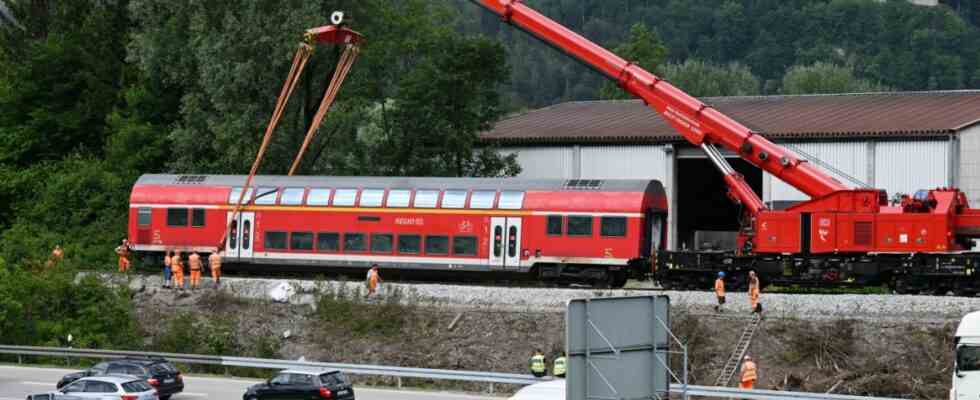The red painted metal arm stretches high into the sky. The rail crane, with the help of which Deutsche Bahn (DB) initiated what may be the last stages of the salvage work on Wednesday morning, has around 160 tons of lifting power – and lifted the last of the five wagons that derailed along with the locomotive on June 3 near Garmisch-Partenkirchen . Five people died in the accident and dozens were injured, some seriously.
The cause is still unclear, the investigations are ongoing and are likely to drag on: those involved do not expect quick results due to the complex situation. At least the salvage work is progressing a bit faster. In the days before, the DB had temporarily repaired the tracks north of the accident site in order to bring a rail crane from Wanne-Eikel in the Ruhr area via Augsburg and Munich. The last one was different in order not to move the 50-ton double-deck car. Lifting it with a crane and putting it back on the tracks “worked really well,” said a DB spokesman. A shunting locomotive then towed the wagon to Farchant.
Nobody can say when the locomotive will be taken away
At the level of the Garmisch district of Oberau, only the locomotive from the accident train is still standing. She had pushed him from behind and is now south of the scene of the accident. The next step is to prepare the tracks that were previously under the car to such an extent that the locomotive can also be transported north. However, no one dares to officially predict when that will happen.
Despite the recent clearing progress, all schedules are still subject to change: the authorities can interrupt work at any time to secure any new tracks. According to DB, the scene of the accident is “still a restricted area”. The use of heavy machinery also holds other surprises. The rail crane, for example, was supposed to lift the car on Tuesday. But first his arrival at the scene of the accident was delayed, then his crew needed additional preparation time in view of the local conditions in order to be able to carry out the rescue safely.
According to DB, the wagons were parked not far from the scene of the accident, and experts should examine them more closely there. For the investigation, the police headquarters in Upper Bavaria South has formed a Soko “Zug”.. The most likely cause of the accident is an unspecified technical defect in the chassis or tracks. Among other things, experts recently brought up a possible track distortion: To put it simply, tracks deform under the weight of the trains rolling over them, which is why repair teams have to correct the deviations from time to time. The experts now have to determine what role the condition of the rail infrastructure actually plays in the Garmisch case.
It also remains unclear for the time being when trains will be able to commute from Munich to Garmisch and back again. Because the section of track around the accident site has not yet been released by the authorities: there are further investigations taking place for the time being, a spokesman for the police headquarters in Upper Bavaria South confirmed on Wednesday. “When these are completed, the railway can continue its work.”
According to reports, the track bed and rails may have to be renewed over several hundred meters before the line can be put back into operation. Until further notice, a rail replacement service will operate between Oberau and Garmisch-Partenkirchen.

